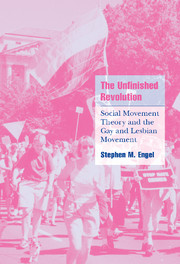Book contents
- Frontmatter
- Contents
- Notes on language
- Preface
- Introduction
- 1 Asked and answered: how questions can condition conclusions in social movement theory
- 2 Tracing the rainbow: an historical sketch of the American gay and lesbian movement
- 3 Tracing the rainbow: an historical sketch of the British gay and lesbian movement
- 4 Where and how it comes to pass: interest group interaction with political institutions
- 5 Asking the unasked question: grappling with the culture variable
- Conclusion
- Appendix: a survey of social movement theories
- Notes
- Bibliography
- Index
Introduction
Published online by Cambridge University Press: 31 October 2009
- Frontmatter
- Contents
- Notes on language
- Preface
- Introduction
- 1 Asked and answered: how questions can condition conclusions in social movement theory
- 2 Tracing the rainbow: an historical sketch of the American gay and lesbian movement
- 3 Tracing the rainbow: an historical sketch of the British gay and lesbian movement
- 4 Where and how it comes to pass: interest group interaction with political institutions
- 5 Asking the unasked question: grappling with the culture variable
- Conclusion
- Appendix: a survey of social movement theories
- Notes
- Bibliography
- Index
Summary
The essential link between author and reader, no matter how great the time difference, is a common humanity, a common psychological makeup or generic consciousness, that grounds the intuitive ability to empathize with other persons.
David Couzens Hoy, The Critical CircleI cannot afford to believe that freedom from intolerance is the right of only one particular group …; so long as we are divided because of our particular identities we cannot join together in effective political action.
Audre LordeWhy this book?
It is a simple question, and often, simple questions have deceptively complex answers. My mentor on this project suggested that I should be able to summarize the objective and findings of this text in three sentences or less. Finally, somewhere nearing the end of this endeavor, I was able to convey what I had written. The following pages disclose a comparative study of the American and British gay and lesbian movements since the end of the Second World War. The aim is to discover in what ways these two social movements interact with governing structures, whether they be separation-of-powers or parliamentary-based, and how those systems influence the goals, strategies, and achievements of these movements. In so doing, I hoped to provide some useful insight into the evolution of social movement theory, its historical trends, and its future directions.
In essence the question boils down to two words: who wins? Are British queers in a better situation than American queers or vice versa? Through this work I attempted a strict social scientific undertaking, or so I had thought over three years ago when I began to research the project.
- Type
- Chapter
- Information
- The Unfinished RevolutionSocial Movement Theory and the Gay and Lesbian Movement, pp. 1 - 10Publisher: Cambridge University PressPrint publication year: 2001

